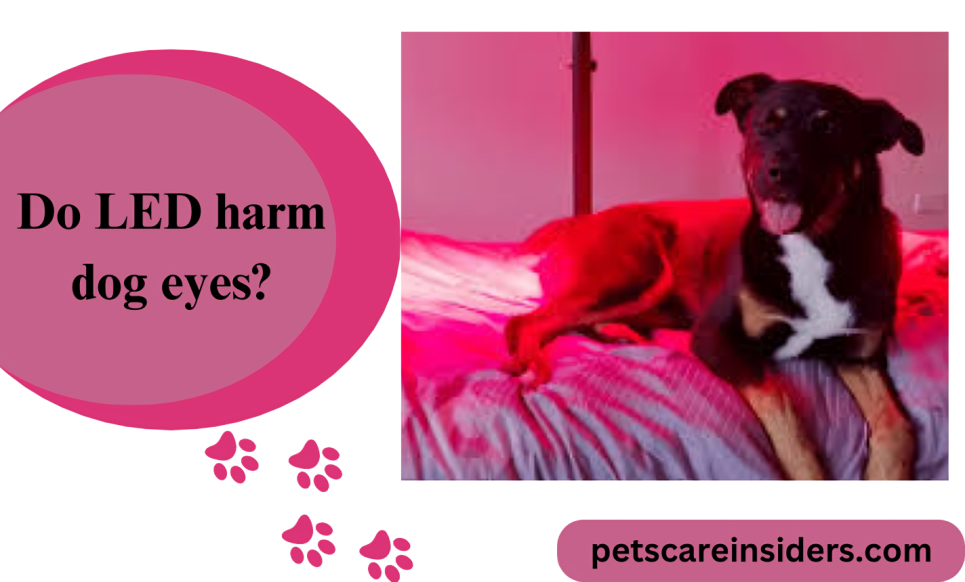Modern, energy-efficient lighting options like LED (light-emitting diode) lights are becoming increasingly common in business and residential settings. LED lights are renowned for their lifespan and efficiency. However, concerns have been raised about whether LED lights harm dog eyes. Discover if LED lights can harm your dog’s eyes, and learn about the potential effects, risks, signs of discomfort, and safe practices to protect your pet’s vision. Learn more about dog care.
LED lights are a flexible option for various lighting requirements because they are available in multiple colors and intensities. Their distinct characteristics, namely their production of blue light, have prompted inquiries regarding their possible influence on well-being, including the health of canines.
Concerns about LED harm dog eyes and Pet Health
Home lighting’s effect on pets’ health has gained attention as pet owners work to provide secure and cozy living spaces for their creatures. Given their unique visual system, dogs might react to artificial lights differently than people do.
Concerns have been expressed that dogs may experience eye strain or discomfort due to LED lights’ intense brightness and blue light emission. Additionally, extended exposure to artificial lighting may hurt a dog’s general well-being because their eyes are designed for low light levels. Awareness of these risks is critical to ensuring our furry friends live in a setting that supports their comfort and health.
LED Lights’ Effect on Dogs’ Eyes
A. Potential Eye Strain on LED harm dog eyes
LED lights, known for their brightness and intensity, can cause eye strain in dogs, similar to how they affect humans. Dogs’ eyes are adapted to see well in low-light conditions, and the stark brightness of LED lights might lead to discomfort or fatigue if exposed for extended periods. Eye strain in dogs can manifest as frequent blinking, squinting, or even avoidance of brightly lit areas.
B. Sensitivity to LED harm dog eyes
Dogs have different sensitivities to light compared to humans, partly due to the structure of their eyes, which contain more rod cells that are efficient in dim lighting. This heightened sensitivity means that intense or harsh lighting, such as that from some LED sources, can be more bothersome to them.
Overexposure to bright LED lights might increase discomfort and stress as dogs struggle to adjust to the intense illumination that sharply contrasts with their natural visual preferences.
C. Light Emission
Blue light, which LED lights emit and are known to induce digital eye strain and interfere with human sleep cycles, is a significant cause for concern. Research on the effects of blue light on dogs is limited, but similar issues could arise.
Blue light penetrates deeper into the eye, potentially causing retinal damage. For dogs, prolonged exposure might increase the risk of ocular damage and disrupt their circadian rhythms, affecting their overall well-being.
Comparing LED Lights with Other Light Sources
A. Incandescent Lights
Incandescent lights produce a warm, yellowish glow that is generally softer on the eyes. They emit light through a filament heated until it glows, offering a natural spectrum of light but consuming more energy and having a shorter lifespan than LEDs.
B. Fluorescent Lights
Fluorescent lights use a chemical reaction involving mercury vapor to produce light, which often has a cooler, harsher quality. Additionally, they are more energy-efficient than incandescent bulbs but can flicker and produce UV radiation, which may be unsettling for humans and pets.
C. Halogen Lights
Halogen lights are incandescent lights that increase their brightness and efficiency with halogen gas. Compared to LEDs, they use less energy and function at greater temperatures, but they still produce a bright, white light that is comparable to that of natural sunshine. Additionally, their lifespan is shorter, which makes them less suitable for long-term use.
Signs of Eye Discomfort in Dogs
A. Behavioral Indicators
Dogs with eye discomfort may avoid brightly lit areas, shield their eyes with their paws, become irritable, or become less interested in activities like playing fetch.
B. Physical Symptoms
Signs include excessive blinking, squinting, and tearing. Redness or inflammation around the eyes is common. Rubbing the eyes against surfaces and persistent discharge also indicate potential eye issues.
Safe Lighting Practices for Pet Owners
A. Choosing the Right LED Lights
Essential Action for Pet owners to cut down on the emission of blue light, choose LED lights with a warmer color temperature. Additionally, seek for lights with “pet-safe” or “sensitive environment” labels.
B. Adjusting Light Intensity
Use dimmable LED lights to control brightness levels. Additionally, adjust lighting to create a comfortable environment, avoiding overly intense illumination.
C. Providing Adequate Dark Periods
Ensure pets have periods of darkness to mimic natural day-night cycles. Furthermore, this helps maintain their circadian rhythms and promotes better sleep and overall well-being.
Research and Expert Opinions on LED harm dog eyes
A. Veterinary Studies on LED Lights
There is limited specific research on the effects of LED lights on pets, including dogs. Additionally, studies generally focus on human responses to light and extrapolate potential impacts on animals. More research is needed to understand how LED lights affect pets’ eyes and overall health.
Expert Recommendations on LED harm dog eyes
Veterinary experts recommend using LED lights with warmer color temperatures to minimize blue light exposure. They advise adjusting light intensity and providing adequate periods of darkness to support pets’ natural rhythms. Additionally, consulting with a veterinarian can provide personalized guidance based on your pet’s specific needs and sensitivities.
Conclusion
LED lights are an energy-efficient and adaptable lighting option for homes, but it’s essential to consider how they might affect pets, especially dogs. Like people, dogs may experience eye strain and discomfort from LED lights due to their strong blue light emission.
To protect their pets, owners must choose LED lights with warmer color temperatures, control light intensity, and provide enough dark hours. However, research is required to understand the long-term effects of LED lights on pets’ health. Seeking assistance from a veterinarian can provide detailed recommendations for creating a safe and comfortable lighting environment for dogs.
